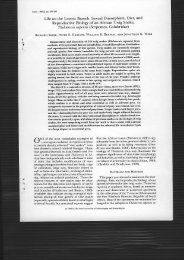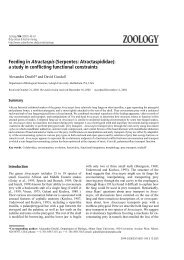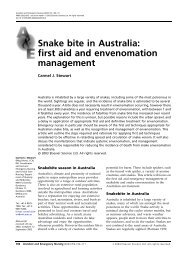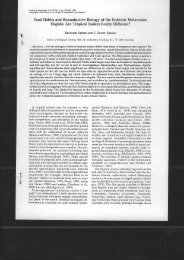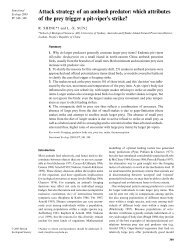Introduction - Kingsnake.com
Introduction - Kingsnake.com
Introduction - Kingsnake.com
You also want an ePaper? Increase the reach of your titles
YUMPU automatically turns print PDFs into web optimized ePapers that Google loves.
Clinical Management of Snakebite in Papua New Guinea Chapter 2<br />
New Guinea small-eyed snake (Micropechis ikaheka)<br />
DESCRIPTION:<br />
This is a thick-bodied snake with an extremely variable colour pattern<br />
based on a greyish head and pale yellow, creamish or salmon coloured<br />
body with dark-tipped scale edges that give rise to broad dark bands<br />
from midbody to the end of the tail. Juvenile snakes are much more<br />
prominently marked than adults (see inset photograph previous page).<br />
In Madang Province the snake is often known as the ‘white snake’ due<br />
to its pale body colour.<br />
SCALATION: Midbody dorsal scale rows are in 15 rows; ventrals number 178-225;<br />
the anal is divided as are 36-55 subcaudals under the tail.<br />
BODY SIZE:<br />
DISTRIBUTION:<br />
HABITAT:<br />
DIET:<br />
REPRODUCTION:<br />
ACTIVITY:<br />
BEHAVIOUR:<br />
MEDICAL<br />
IMPORTANCE:<br />
ANTIVENOM:<br />
Average length is from 1.2-1.4 metres; maximum length is 2.1 metres.<br />
Recorded from northern Western Province (Kiunga to Star Mountains);<br />
and all of the Highland and New Guinea Provinces. Isolated records in<br />
Gulf and Central Provinces. Widely distributed in West Papua and the<br />
Aru Islands.<br />
Lives in wet environments from sea level to over 1,500 metres.<br />
Common in monsoonal forests, lowland swamps and rainforests where<br />
it lives in ground debris. There are abundant regional populations in and<br />
around Cocoa plantations (especially Karkar Island) where the snake<br />
lives in old coconut husk piles.<br />
Believed to be an opportunistic feeder, preying on a wide variety of<br />
small ground dwelling animals including lizards, rodents, frogs and<br />
particularly other snakes, including its own species.<br />
Nothing is currently known although juvenile snakes have been<br />
collected in the wild.<br />
Although generally considered to be a ground dwelling largely<br />
nocturnal species, there is a single report from West Papua of a serious<br />
snakebite having been caused by a large Micropechis ikaheka that was<br />
caught in a bird trap high in a tree.<br />
During the dry season this snake is a <strong>com</strong>mon inhabitant of coconut<br />
husk piles, but appears to disperse during the wet season and may be<br />
encountered at night moving on the ground.<br />
A shy snake until disturbed. If handled this snake is very aggressive and<br />
will bite readily, often chewing down hard and refusing to let go of its<br />
victim. Small specimens are very agile and surprisingly fast.<br />
The small eyes and smooth body scales are specific adaptations for<br />
foraging among ground debris and loose topsoil.<br />
This highly venomous snake is believed to account for only a small<br />
proportion of snakebites in the mainland Madang and Sepik regions,<br />
however one study found that approximately 40% of snakebites on<br />
Karkar Island could be attributed to bites by Micropechis ikaheka (see<br />
CHAPTER 3 for venom data).<br />
CSL polyvalent antivenom.<br />
- 2.15 -




